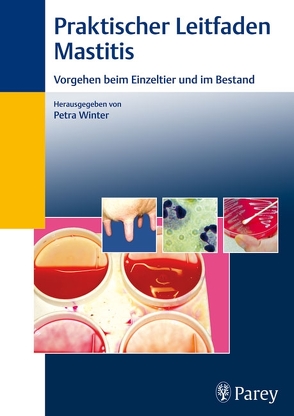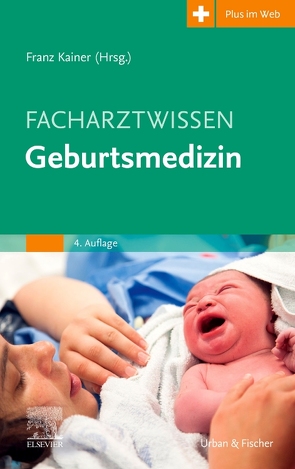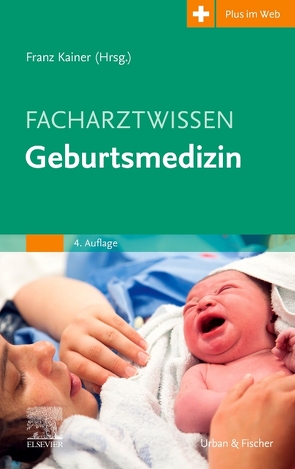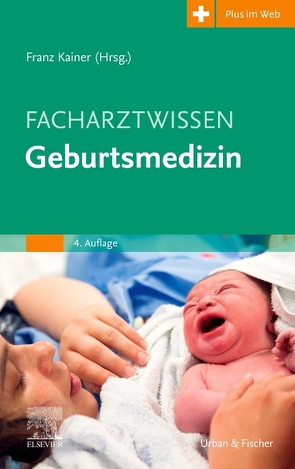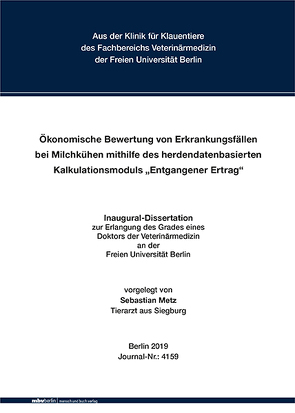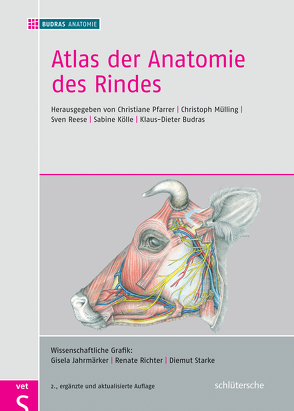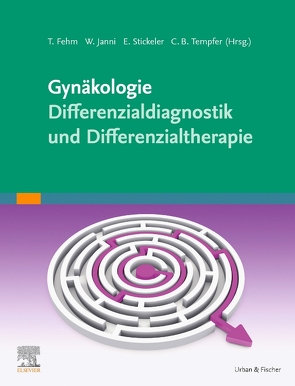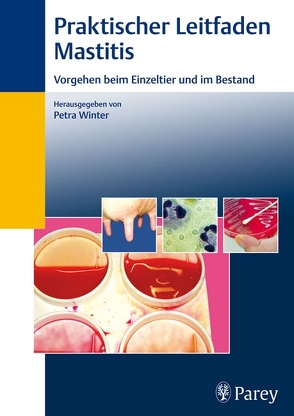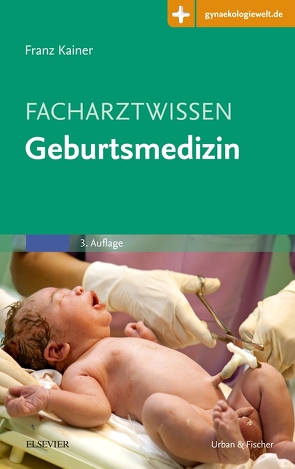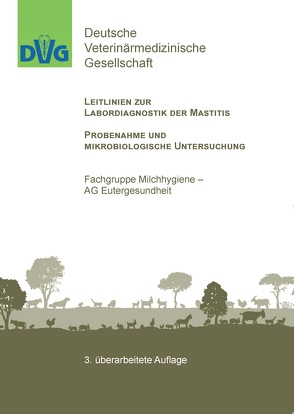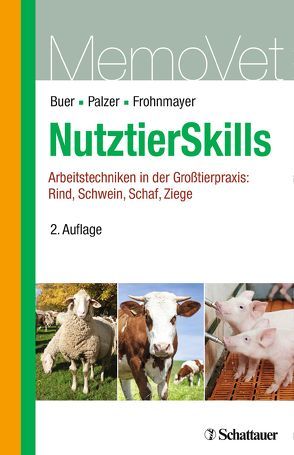
Von Auskultation bis Zitzenverletzung – Fit für die Großen!
Die „NutztierSkills“ vermitteln bewährt praxisnah die wichtigsten Basics und Fertigkeiten für den Alltag in der Großtierpraxis.
Alle gängigen Untersuchungs- und Behandlungstechniken werden profund erläutert, ebenso die häufigsten Operationen, geburtshilfliche Maßnahmen und das richtige Vorgehen bei Notfällen. Darüber hinaus gibt es Hinweise zum Berufsstart, zur Ausstattung von Praxiswagen und Arbeitsutensilien sowie zum Umgang mit den Kunden.
Neu in der 2. vollständig aktualisierten Auflage sind Erweiterungen zur Bestandsbetreuung und Klauenbehandlung, modernes Anästhesie- und Schmerzmanagement sowie die Berücksichtigung der neuen Richtlinien des aktuellen Arzneimittel- und Tierschutzrechts.
Profitieren Sie von der langjährigen Erfahrung ausgewiesener Experten aus der Nutztierpraxis: Mit zahlreichen Tipps und wichtigen Hinweisen zu typischen Fallstricken lässt Sie dieser „Kitteltaschenguide“ den Praxisalltag mit Rinder-, Schweine-, Schaf- und Ziegenpatienten souverän meistern.
Aktualisiert: 2023-06-26
> findR *

Von Auskultation bis Zitzenverletzung – Fit für die Großen!
Die „NutztierSkills“ vermitteln bewährt praxisnah die wichtigsten Basics und Fertigkeiten für den Alltag in der Großtierpraxis.
Alle gängigen Untersuchungs- und Behandlungstechniken werden profund erläutert, ebenso die häufigsten Operationen, geburtshilfliche Maßnahmen und das richtige Vorgehen bei Notfällen. Darüber hinaus gibt es Hinweise zum Berufsstart, zur Ausstattung von Praxiswagen und Arbeitsutensilien sowie zum Umgang mit den Kunden.
Neu in der 2. vollständig aktualisierten Auflage sind Erweiterungen zur Bestandsbetreuung und Klauenbehandlung, modernes Anästhesie- und Schmerzmanagement sowie die Berücksichtigung der neuen Richtlinien des aktuellen Arzneimittel- und Tierschutzrechts.
Profitieren Sie von der langjährigen Erfahrung ausgewiesener Experten aus der Nutztierpraxis: Mit zahlreichen Tipps und wichtigen Hinweisen zu typischen Fallstricken lässt Sie dieser „Kitteltaschenguide“ den Praxisalltag mit Rinder-, Schweine-, Schaf- und Ziegenpatienten souverän meistern.
Aktualisiert: 2023-06-26
> findR *
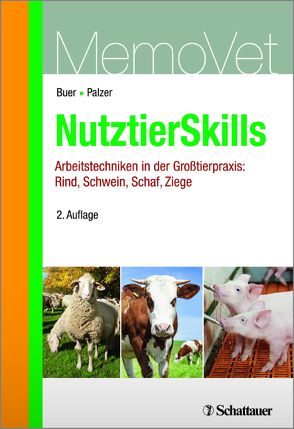
Von Auskultation bis Zitzenverletzung – Fit für die Großen!
Die „NutztierSkills“ vermitteln bewährt praxisnah die wichtigsten Basics und Fertigkeiten für den Alltag in der Großtierpraxis.
Alle gängigen Untersuchungs- und Behandlungstechniken werden profund erläutert, ebenso die häufigsten Operationen, geburtshilfliche Maßnahmen und das richtige Vorgehen bei Notfällen. Darüber hinaus gibt es Hinweise zum Berufsstart, zur Ausstattung von Praxiswagen und Arbeitsutensilien sowie zum Umgang mit den Kunden.
Neu in der 2. vollständig aktualisierten Auflage sind Erweiterungen zur Bestandsbetreuung und Klauenbehandlung, modernes Anästhesie- und Schmerzmanagement sowie die Berücksichtigung der neuen Richtlinien des aktuellen Arzneimittel- und Tierschutzrechts.
Profitieren Sie von der langjährigen Erfahrung ausgewiesener Experten aus der Nutztierpraxis: Mit zahlreichen Tipps und wichtigen Hinweisen zu typischen Fallstricken lässt Sie dieser „Kitteltaschenguide“ den Praxisalltag mit Rinder-, Schweine-, Schaf- und Ziegenpatienten souverän meistern.
Aktualisiert: 2023-06-26
> findR *
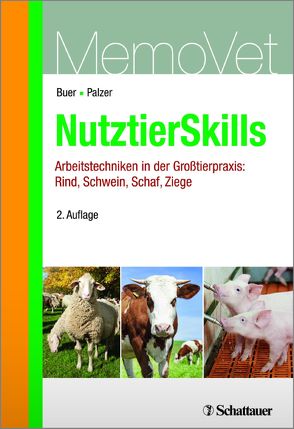
Von Auskultation bis Zitzenverletzung – Fit für die Großen!
Die „NutztierSkills“ vermitteln bewährt praxisnah die wichtigsten Basics und Fertigkeiten für den Alltag in der Großtierpraxis.
Alle gängigen Untersuchungs- und Behandlungstechniken werden profund erläutert, ebenso die häufigsten Operationen, geburtshilfliche Maßnahmen und das richtige Vorgehen bei Notfällen. Darüber hinaus gibt es Hinweise zum Berufsstart, zur Ausstattung von Praxiswagen und Arbeitsutensilien sowie zum Umgang mit den Kunden.
Neu in der 2. vollständig aktualisierten Auflage sind Erweiterungen zur Bestandsbetreuung und Klauenbehandlung, modernes Anästhesie- und Schmerzmanagement sowie die Berücksichtigung der neuen Richtlinien des aktuellen Arzneimittel- und Tierschutzrechts.
Profitieren Sie von der langjährigen Erfahrung ausgewiesener Experten aus der Nutztierpraxis: Mit zahlreichen Tipps und wichtigen Hinweisen zu typischen Fallstricken lässt Sie dieser „Kitteltaschenguide“ den Praxisalltag mit Rinder-, Schweine-, Schaf- und Ziegenpatienten souverän meistern.
Aktualisiert: 2023-06-26
> findR *
Lernen Sie von der Prophylaxe bis hin zur Therapie die Mastitisproblematik sowohl beim Einzeltier als auch der Herde kennen:
Erkrankungsursachen und Pathogenese
Untersuchung und Diagnostik auf Einzeltier- und Herdenebene
Untersuchung von Milchproben und Erregeridentifizierung
Herdenüberwachung und Mastitisprophylaxe auf Bestandsebene
Therapie inkl. Zitzenverletzungen
Flussdiagramme zeigen Ihnen das systematische Vorgehen und helfen Ihnen bei wichtigen Entscheidungen.
Eine wichtige Unterstützung, die diagnostischen und kurativen Maßnahmen zu optimieren, Managementfehler (Melktechnik, Hygiene etc.) und Risikopunkte schneller zu erkennen und den Landwirt bezüglich Prophylaxemaßnahmen effektiver zu beraten.
Aktualisiert: 2023-06-14
> findR *
Aktualisiert: 2023-05-22
> findR *
Aktualisiert: 2023-05-11
> findR *

Produktinformationen zu „Bircher-Benner-Handbuch: Bd.16 Bircher-Benner Handbuch für Frauenleiden und die Wechseljahre“.
Dieses Buch ist für Frauen geschrieben, welche ihr eigenes Wesen besser verstehen möchten und nach einem Weg suchen, ihren Beschwerden in natürlicher Weise zu begegnen und diese zu heilen. Es ist auch für Männer geschrieben, die dies besser verstehen möchten. Viele Frauen leiden still und tapfer vor sich hin, mit monatlichen oder klimakterischen Beschwerden, und Krankheiten, die in natürlicher Weise vermieden und geheilt werden können, wenn man deren Ursache kennt. Die intimsten Ereignisse der Weiblichkeit, die Schwangerschaft, die Geburt und die Stillzeit sind in diesem Buch eingehend beschrieben, Zeiten in welchen Frauen grösstes Verständnis, Achtung und Respekt verdienen. Auch sind darin alle möglichen Komplikationen und Frauenkrankheiten eingehend beschrieben, mit allen Möglichkeiten, sie in natürlicher Weise zu verhüten und zu heilen. Diesem Buch liegt die neuste wissenschaftliche Evidenz zu Grunde und die jahrzehntelange Erfahrung aus der weltberühmten Bircher-Benner Klinik. Dieses Buch wird durch die Diätetik im Bircher-Benner Handbuch Nr. 15: «Für die Ernährung in der Schwangerschaft und Stillzeit», ergänzt. Für den Arzt bedeuten diese beiden Bücher eine grosse Zeitersparnis und eine wertvolle Hilfe bei der Führung und Begleitung seiner Patientinnen.
Aktualisiert: 2022-05-24
> findR *
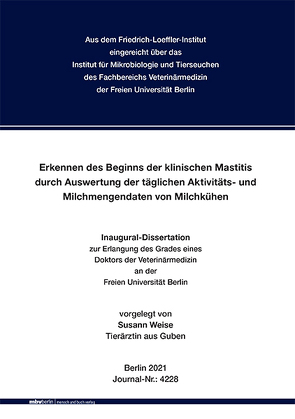
Detection of the start of clinical mastitis by analysing daily activity and milk yield data in dairy cows
Mastitis is the disease with the highest economic impact in dairy production. As it is a multifactorial disease, different factors influence the emergence of mastitis and the clinical occurrence can be divers. Digitalization in the dairy barn, known as precision dairy farming, has the potential to serve as a syndromic surveillance system. The detection of a beginning clinical mastitis by changes in milk yield and behavior may allow early recognition and treatment of the cow at risk.
In this study, individual milk yields and activity variables of holstein frisian dairy cows housed in freestall barns in two dairy farms (farm 1 hold 1100 and farm 2 hold 400 milking cows) were investigated for deviations of this variables in the days, before clinical mastitis was diagnosed. Documented mastitis events in the herd management software Dairy Comp305 were used to identify mastitis periods. The cows were equipped with activity sensors (IceQubes of IceRobotics LtD, South Queensferry, UK).
First, the absolute values of daily milk yields and activity values (lying time, standing time, steps, motion index and changes of standing to lying) were examined ten days before the documented mastitis event. After that, the individual relative deviation five days before mastitis was calculated for all listed variables.
Due to the indirect proportional relationship of standing time and lying time and the lack of statistical significance of changes between standing and lying concerning the development of mastitis, the number of variables were reduced to the relative deviation in milk yield, lying time and motion index. On day two before the documented mastitis, the chosen variables were significant compared to the control periods.
The relative deviations of milk yield, lying time and motion index were used to distinguish between animals with mastitis and a control group. In farm 1, a combination of cut-off points led to a sensitivity of 70 % and a specificity of 40 %. In farm 2, the sensitivity of 70 % and specificity of 63.6 % was reached.
When the effect of the lactation phase on the deviation in milk yield and the individual activity to the group activity was taken into account, it became evident that this was no meaningful advantage in distinguishing mastitis periods from a control periods by relative deviations.
So far, no comparable number of mastitis events over such a long period was used for analysing this topic. It has to be noted however, that further analyses may be necessary, which could utilize more detailed information about clinical mastitis. It will also be important to check the insights of this thesis during the daily work in dairy farms.
Aktualisiert: 2021-06-24
> findR *
Aktualisiert: 2023-05-01
> findR *
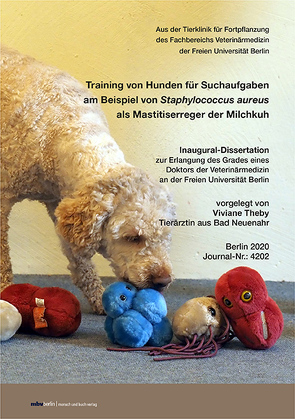
"Training sniffer dogs to detect Staphylococcus aureus in mastitis-milk"
Dogs and their ability to perceive smells even in extremely weak concentrations offer us many possibilities, even in diagnostic areas in medicine.
In this study, using Staphylococcus aureus as a mastitis pathogen in dairy cows, we tested whether it is possible to develop a training protocol for dogs, to recognize and indicate this bacterium in milk.
The training protocol, developed in this study, can serve as a guide to train dogs to differentiate odor of bacteria and is meant as a basis for further development and improvement.
Ten dog handlers took part in this study with their private dogs. It was carried out in 4 experiments.
The dogs were initially trained to indicate Staphylococci grown on agar plates. In the test, 8 dogs examined 100 samples each, 10 of which contained odor of Staphylococcus aureus. Four dogs correctly displayed all positive samples and achieved a sensitivity and specificity of 100%. On average of all dogs the sensitivity was 91,3 % and the specificity 97,9 %.
In the second experiment, the dogs were asked to recognize Staphylococcus aureus in milk. In this experiment, the dogs had difficulty identifying the target smell. We speculate that the concentration of the bacteria for training was probably too low. Only 2 out of 6 dogs completed all 10 trials. The sensitivity was 55 % and the specificity 95 %. For all dogs the sensitivity was 33,3 % and specificity 92,4 %.
The training protocol for experiment 3 was then adapted and intermediate steps were incorporated in which the dogs were slowly accustomed to lower bacterial concentrations. In the next test, each dog searched a total of 105 samples with odorants in 15 rounds of 7 samples each. The dogs achieved an average sensitivity of 83,3 % and a specificity of 97,9 %.
The last experiment tested whether dogs trained in this way are able to recognize Staphylococcus aureus in milk that comes from dairy cows suffering from mastitis. 5 out of 6 dogs successfully passed the test. The dogs achieved an average sensitivity of 60 % and a specificity of 92,8 %. One dog recognized 8 of 9 out of 70 samples with the target smell and had a sensitivity of 88,9 % and specificity of 95,1 %.
Dog training for odor differentiation of bacteria is possible. With the developed training protocol, not all dogs were able to complete the task in the given time. There are many individual differences that should be discussed in more detail in the training protocol. It became obvious that small training steps are important for achieving the training objective. The change in concentration of the target odor must also be considered as an important training step.
This is the first work to show that dogs can recognize and indicate Staphylococcus aureus in milk from dairy cows with mastitis. A training protocol was created, with which 75 % of the dogs reached the training goal and which can serve as the basis for training dogs to distinguish other types of bacteria.
Aktualisiert: 2022-12-31
> findR *
Erstes deutschsprachiges Werk zur Anatomie des Rindes in dieser Form in 2. Auflage.
Fortsetzung des bewährten Lehrkonzeptes für die Anatomie der Haussäugetiere
Grundlage für das Studium der Anatomie des Rindes
Nachschlagewerk für Tiermediziner aus Wissenschaft und Praxis
Aktualisiert: 2022-03-31
> findR *
Aktualisiert: 2023-05-01
> findR *
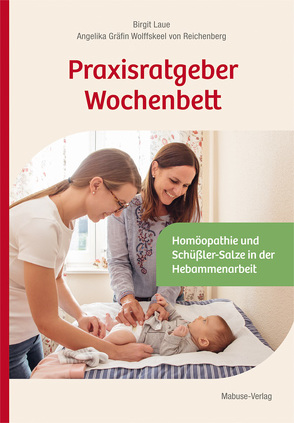
Hebammen begleiten mit ihrem Wissen junge Mütter und Familien, um sie auf die Geburt und die Zeit danach ideal vorzubereiten. Homöopathie und Schüßler-Salzen sind ein wichtiger Bestandteil in der Betreuung durch Hebammen. Bei Befindlichkeitsstörungen und Beschwerden bieten sie eine natürliche Erweiterung des medizinischen Repertoires.
Dieses anwendungsorientierte und übersichtliche Buch der beiden Fachautorinnen liefert verlässliche Empfehlungen für die wichtigsten Beschwerden im Wochenbett und in der Stillzeit bei Mutter und Kind, wie etwa schmerzhafte Nachwehen, Wundheilungsstörungen bei Geburtsverletzungen, Milchstau, Nabelentzündungen und Zahnungsbeschwerden. Es kombiniert erstmals homöopathische Arzneimittel und Schüßler-Salze.
Mit den vier Hauptkapiteln:
1. Grundlagen der Homöopathie und der Mineralsalz-Therapie nach Schüßler
2. Die Gesundheit der Mutter im Wochenbett
3. Die Stillzeit
4. Der Säugling
Jedes Kapitel wird eingeleitet von einer Beschreibung der Beschwerden, Nennung von Symptomen und Maßnahmen. Darauf folgen empfohlene Homöopathische Arzneimittel und Schüßler-Salze mit Erläuterungen. Beratungs- und Behandlungstipps schließen das Kapitel ab.
Aktualisiert: 2023-04-24
> findR *

Liebling, wir sind schwanger! Und dann ist das Baby da und hat Hunger. Wer Stillen möchte, ist plötzlich mit eigenartigen Veränderungen des Körpers konfrontiert: Die Brüste schwellen plötzlich auf Melonengröße an. Beflissene Milchpumpenvertreterinnen tauchen ungefragt am Bett der Wöchnerin auf. Die Hebamme klärt einen über die wundersame Wirkung von Quarkwickeln und Kohlblättereinlagen für den Still-BH auf. Und dann droht auch noch die gefürchtete Still-Demenz!
Wenn man zum ersten Mal ein Baby bekommt, gibt es so einige Überraschungen: Irgendwie hatte einen niemand darauf vorbereitet, wie krass eine Geburt wirklich ist. Und auch bezüglich des Stillens scheint es eine Verschwörung der Eingeweihten zu geben. Die skurrilen Vorgänge, die damit verbunden sind, erfährt man erst, wenn man sie an der eigenen Brust erlebt ...
Theresa Thönnissens humorvoller Ratgeber "Mein Jahr als Säugetier. Das ehrliche Stillbuch" hilft stillenden Müttern in allen Lebenslagen, Ruhe im Sturm zu bewahren. Oder danach zumindest wieder über sich selbst lachen zu können!
Aktualisiert: 2023-04-05
> findR *
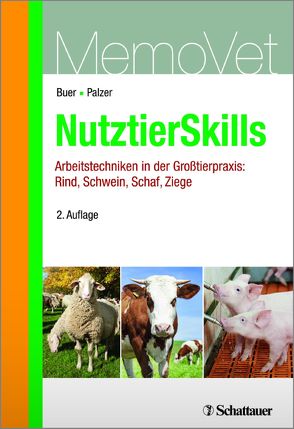
Von Auskultation bis Zitzenverletzung – Fit für die Großen!
Die „NutztierSkills“ vermitteln bewährt praxisnah die wichtigsten Basics und Fertigkeiten für den Alltag in der Großtierpraxis.
Alle gängigen Untersuchungs- und Behandlungstechniken werden profund erläutert, ebenso die häufigsten Operationen, geburtshilfliche Maßnahmen und das richtige Vorgehen bei Notfällen. Darüber hinaus gibt es Hinweise zum Berufsstart, zur Ausstattung von Praxiswagen und Arbeitsutensilien sowie zum Umgang mit den Kunden.
Neu in der 2. vollständig aktualisierten Auflage sind Erweiterungen zur Bestandsbetreuung und Klauenbehandlung, modernes Anästhesie- und Schmerzmanagement sowie die Berücksichtigung der neuen Richtlinien des aktuellen Arzneimittel- und Tierschutzrechts.
Profitieren Sie von der langjährigen Erfahrung ausgewiesener Experten aus der Nutztierpraxis: Mit zahlreichen Tipps und wichtigen Hinweisen zu typischen Fallstricken lässt Sie dieser „Kitteltaschenguide“ den Praxisalltag mit Rinder-, Schweine-, Schaf- und Ziegenpatienten souverän meistern.
Aktualisiert: 2022-03-02
> findR *
Lernen Sie von der Prophylaxe bis hin zur Therapie die Mastitisproblematik sowohl beim Einzeltier als auch der Herde kennen:
Erkrankungsursachen und Pathogenese
Untersuchung und Diagnostik auf Einzeltier- und Herdenebene
Untersuchung von Milchproben und Erregeridentifizierung
Herdenüberwachung und Mastitisprophylaxe auf Bestandsebene
Therapie inkl. Zitzenverletzungen
Flussdiagramme zeigen Ihnen das systematische Vorgehen und helfen Ihnen bei wichtigen Entscheidungen.
Eine wichtige Unterstützung, die diagnostischen und kurativen Maßnahmen zu optimieren, Managementfehler (Melktechnik, Hygiene etc.) und Risikopunkte schneller zu erkennen und den Landwirt bezüglich Prophylaxemaßnahmen effektiver zu beraten.
Aktualisiert: 2020-01-01
> findR *
Das gesamte Facharztwissen zum schnellen Nachschlagen -– im klinischen Alltag und im Kreißsaal sowie zur gezielten Vorbereitung auf die Facharztprüfung - übersichtlich und wissenschaftlich fundiert.
Der „Kainer" unterstützt - auch bei geburtshilflich schwierigen Fragestellungen und Problemfällen.
Neu in der 3. Auflage:
-> Kapitel Adipositas
-> Stark überarbeitet und aktualisiert: Diabetes und Infektionen
-> Einarbeitung der neuen Leitlinien
Aktualisiert: 2021-02-05
> findR *
Leitlinien zur Labordiagnostik der Mastitis - Probenahme und mikrobiologische Untersuchung.
AG Eutergesundheit der Fachgruppe Milchhygiene des Arbeitskreises Lebensmittelhygiene
Aktualisiert: 2019-01-23
> findR *
MEHR ANZEIGEN
Bücher zum Thema MASTITIS
Sie suchen ein Buch über MASTITIS? Bei Buch findr finden Sie eine große Auswahl Bücher zum
Thema MASTITIS. Entdecken Sie neue Bücher oder Klassiker für Sie selbst oder zum Verschenken. Buch findr
hat zahlreiche Bücher zum Thema MASTITIS im Sortiment. Nehmen Sie sich Zeit zum Stöbern und finden Sie das
passende Buch für Ihr Lesevergnügen. Stöbern Sie durch unser Angebot und finden Sie aus unserer großen Auswahl das
Buch, das Ihnen zusagt. Bei Buch findr finden Sie Romane, Ratgeber, wissenschaftliche und populärwissenschaftliche
Bücher uvm. Bestellen Sie Ihr Buch zum Thema MASTITIS einfach online und lassen Sie es sich bequem nach
Hause schicken. Wir wünschen Ihnen schöne und entspannte Lesemomente mit Ihrem Buch.
MASTITIS - Große Auswahl Bücher bei Buch findr
Bei uns finden Sie Bücher beliebter Autoren, Neuerscheinungen, Bestseller genauso wie alte Schätze. Bücher zum
Thema MASTITIS, die Ihre Fantasie anregen und Bücher, die Sie weiterbilden und Ihnen wissenschaftliche
Fakten vermitteln. Ganz nach Ihrem Geschmack ist das passende Buch für Sie dabei. Finden Sie eine große Auswahl
Bücher verschiedenster Genres, Verlage, Autoren bei Buchfindr:
Sie haben viele Möglichkeiten bei Buch findr die passenden Bücher für Ihr Lesevergnügen zu entdecken. Nutzen Sie
unsere Suchfunktionen, um zu stöbern und für Sie interessante Bücher in den unterschiedlichen Genres und Kategorien
zu finden. Unter MASTITIS und weitere Themen und Kategorien finden Sie schnell und einfach eine Auflistung
thematisch passender Bücher. Probieren Sie es aus, legen Sie jetzt los! Ihrem Lesevergnügen steht nichts im Wege.
Nutzen Sie die Vorteile Ihre Bücher online zu kaufen und bekommen Sie die bestellten Bücher schnell und bequem
zugestellt. Nehmen Sie sich die Zeit, online die Bücher Ihrer Wahl anzulesen, Buchempfehlungen und Rezensionen zu
studieren, Informationen zu Autoren zu lesen. Viel Spaß beim Lesen wünscht Ihnen das Team von Buchfindr.




